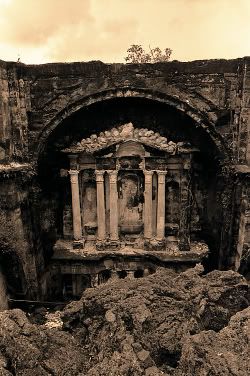

Volcán Paricutín/,
cementerio de piedras/
jardín nuevo/
poesía purépecha
It was around 4pm on 20 February, 1943 when Paricutín volcano rumbled and was born in Dionisio Pulido´s corn field near the town of San Juan Parangaricutiro. Twenty four hours later the volcano was 7 metres tall. A week later it was 50 metres. In 1955 it reached its final height of 600. Of the town of Parangaricutiro only the towers of its church and the main altar survived. The rest of the church (the roof caved in and burned) and the town were buried in lava. A new San Juan was built and it is called Nuevo San Juan Parangaricutiro. Paricutín is surrounded by more than 2000 squat old volcanic cones. They and Paricutín will never likely erupt again. While the area is an intense volcanic zone, the craters are called monogenetic. They have a first and only phase and they die so that the volcanos are never big. But it is possible that at any time Paricutín could have some live competition.
Thirty two years ago, Rosemary, Ale and I departed from the little nearby town of Angahuan on horseback with a guide. We reached the buried church of San Juan. I barely had time to take some pictures (above & right) when a terrible rain unleashed on us. Our guide handed us three ponchos and when we returned to Angahuan our clothes were of multiple colour. The ponchos had run!
Today, it would seem that nothing has changed much. Access to the buried church and the volcano is still on horseback. One has the option of walking, but in the dry season the volcanic ash is very deep and in the rainy season (now) the ash is sticky mud. We went on horseback again. Rebecca's horse was called Chiquito , Rosemary rode on Sansu and my matungo (nag) was Cantarito. Florencio, our guide, made sure we were safe and when we climbed to the church, through the intense lava fields on foot, he made sure we didn't fall. The only change was a welcome one. We were greeted by a mouthwatering smell that came from a small collection of huts (right next to the edge of the lava field and very close to the church). Under the huts Purépecha Indian women, dressed in brilliant huipiles prepared the best flor the calabaza (pumpkin flower) quezadillas I have ever had in my life. The handmade tortillas were an intense blue from the just picked blue corn of the area. Hector and his wife Cass, Ilse and her husband Andrew (Ale's godfather and my friend of 40 years), Rosemary and Rebecca and I ate until we were more than satisfied. Five minutes after Florencio led us back to Angahuan it poured so intensely that the dirt roads of the town became rivers. When we finally arrived to Uruapan there was no electricity. In fact the storm was so large that even Morelia suffered Uruapan's fate.
When Florencio found out that I had been to the church all those years ago, he told me in his accented Spanish ( he speaks a Purépecha dialect), " You may have walked through the spirits of your wife, your daughter and yourself which have remained here all those years. Paricutín no suelta (does not let go)."